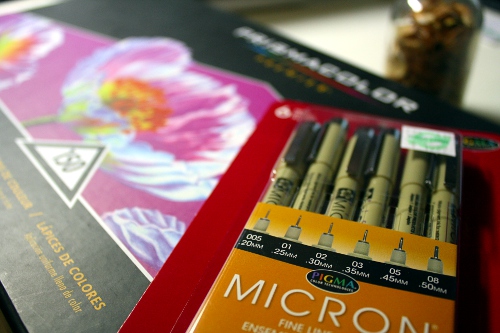
Pencils: For the most part, graphite is graphite. I still sometimes draw with good old fashioned #2 pencils but for the sake of not needing to carry a sharpener or find somewhere to dispose of pencil shavings, I almost always use a mechanical pencil. I have a 0.9mm mechanical with a blue lead, a 0.7mm H, and a 0.5mm HB both with regular graphite leads. For archival purposes I finish pencil drawings with Prismacolor Fixative. For colored pencils I use Prismacolor Premier. There are other professional grade pencils out there, but I just love how these lend themselves to the techniques I like to use.
Pens: My Sharpies and ball points have been replaced with a wide range of Pigma Micron pens. I have and use every size from 005 through 08 and also their Graphic and Brush tips. Microns are waterproof and archival and I've tested the former by using watercolor to color some of my ink drawings. The Microns did not bleed at all when exposed to water.
Paint: I used craft grade paint when I first started painting in 2006. I've mostly experienced no problems with this until I started exhibiting at outdoor art fairs here in Florida. The humidity and hot sun have cracked some of my paintings, causing me to go back and sand the canvas and repaint affected areas with higher quality paints. Since around 2010 I've been using Liquitex Heavy Body and Golden Fluid acrylics. These are quality, high pigment paints. (Tip: Home Depot, Lowes, and WalMart have "oops paint" in large and small containers for extremely discounted prices. They are usually high quality brand name paints intended for interior/exterior jobs. I use these paints for laying down backgrounds and painting large areas, then use more expensive Golden and Liquitex for the detail work.)
Paper: Printer paper was my best friend for many years and I still use it for very rough drafts that I know will be recycled. The problem with it is that it is thin and fragile. Overworking it will causes the paper to buckle and warp. I try to use Strathmore 300 series Brisol in 100lb thickness for all drawing work. You never know when a piece will come out well and if you're working on throw-away paper and find out you're creating a masterpiece, you're stuck. It's better to start out on good paper in case you make a winner.
Wood: I get asked very regularly what kind of wood I draw on. The first wood pieces I drew and painted were on pieces of pine trim I cut down after installing a door in my home. I've also painted on Masonite purchased from hardware stores that I applied gesso to. (Tip: If using Masonite, gesso a large X on the back to keep it from warping when you gesso the front.) If you want a more exhibit friendly wood, cradled basswood can be purchased at art supply stores. You should experiment with a few different substrates to find out what works best for you.
I know some of you are thinking that getting the right tools for the job will cost a lot of money. I am not condemning anyone for using whatever materials you have on hand. Again, I have created and sold hundreds of original pieces with whatever was lying around the house. However, I will venture to assume that if you have a smartphone, subscription television, or a gaming system then you have found ways to acquire the unnecessary things you find important. If your art is important to you and you want to elevate your game then getting quality materials will certainly pay off. Just my two cents. Most importantly, have fun with it!
Bryan
Shop online at http://www.bryancollins.etsy.com

No comments:
Post a Comment